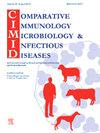Epidemiology and genetic diversity of pathogenic Leptospira among Rattus norvegicus in urban residential areas of Guangzhou, Southern China
IF 2
3区 农林科学
Q4 IMMUNOLOGY
Comparative Immunology Microbiology and Infectious Diseases
Pub Date : 2025-02-07
DOI:10.1016/j.cimid.2025.102322
引用次数: 0
Abstract
Leptospirosis, a zoonotic disease caused by pathogenic Leptospira spirochetes, poses a significant global public health threat. Rodents, particularly those inhabiting urban environments, are recognized as the primary reservoirs for human infections. Therefore, conducting epidemiological studies on pathogenic Leptospira in urban rodent populations is essential for evaluating the risk of human leptospirosis. In this study, we captured 263 Rattus norvegicus from urban residential areas across five districts in Guangzhou to access the prevalence and genetic diversity of pathogenic Leptospira. Our findings revealed the presence of two pathogenic Leptospira species, L. interrogans and L. borgpetersenii, which are the primary pathogens responsible for human leptospirosis in China, in four of the five districts, with an overall prevalence of 10.3 %. Given the close proximity of R. norvegicus to human populations in urban areas, this significant prevalence of pathogenic Leptospira indicates an elevated risk of leptospirosis outbreaks among residents of Guangzhou. These results highlight the urgent need for ongoing monitoring of pathogenic Leptospira infections in urban rodent populations to prevent and control potential outbreaks of leptospirosis in the city.
广州城市居民区褐家鼠致病性钩端螺旋体的流行病学及遗传多样性
钩端螺旋体病是一种由致病性钩端螺旋体引起的人畜共患疾病,对全球公共卫生构成重大威胁。啮齿动物,特别是生活在城市环境中的啮齿动物,被认为是人类感染的主要宿主。因此,开展城市啮齿动物致病性钩端螺旋体的流行病学研究对评估人类钩端螺旋体病的风险至关重要。本研究在广州市5个城区捕获褐家鼠263只,了解致病性钩端螺旋体的流行情况和遗传多样性。结果显示,5个区中有4个区存在两种致病性钩端螺旋体,审问钩端螺旋体和博格彼得钩端螺旋体是中国人类钩端螺旋体病的主要病原体,总流行率为10.3 %。鉴于褐家鼠与城市人群的距离较近,致病性钩端螺旋体的显著流行表明广州居民中钩端螺旋体病暴发的风险较高。这些结果突出表明,迫切需要持续监测城市啮齿动物种群中致病性钩端螺旋体感染,以预防和控制城市中可能发生的钩端螺旋体病暴发。
本文章由计算机程序翻译,如有差异,请以英文原文为准。
求助全文
约1分钟内获得全文
求助全文
来源期刊
CiteScore
4.60
自引率
0.00%
发文量
102
审稿时长
40 days
期刊介绍:
Comparative Immunology, Microbiology & Infectious Diseases aims to respond to the concept of "One Medicine" and to provide a venue for scientific exchange. Based on the concept of "Comparative Medicine" interdisciplinary cooperation between specialists in human and animal medicine is of mutual interest and benefit. Therefore, there is need to combine the respective interest of physicians, veterinarians and other health professionals for comparative studies relevant to either human or animal medicine .
The journal is open to subjects of common interest related to the immunology, immunopathology, microbiology, parasitology and epidemiology of human and animal infectious diseases, especially zoonotic infections, and animal models of human infectious diseases. The role of environmental factors in disease emergence is emphasized. CIMID is mainly focusing on applied veterinary and human medicine rather than on fundamental experimental research.

 求助内容:
求助内容: 应助结果提醒方式:
应助结果提醒方式:


